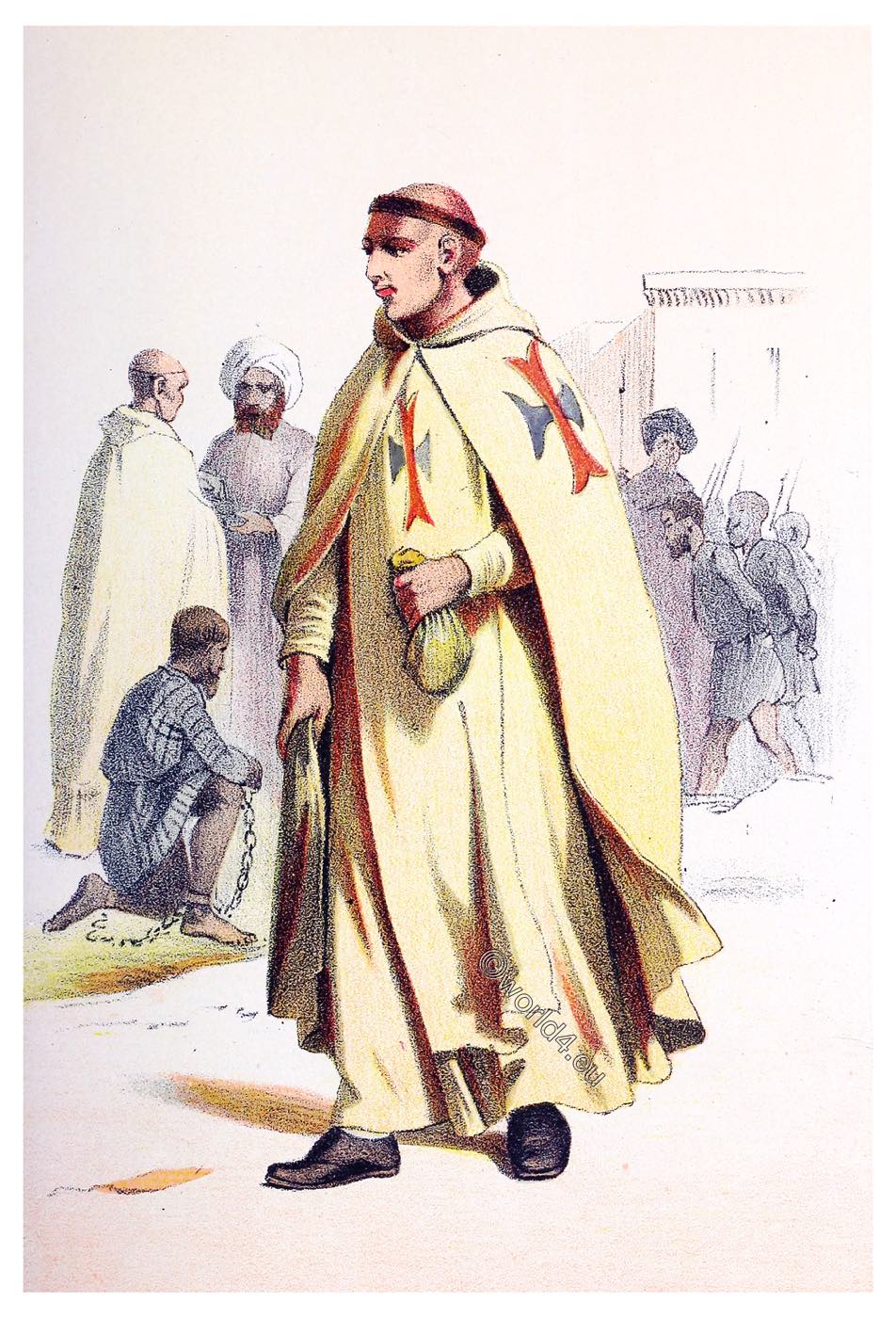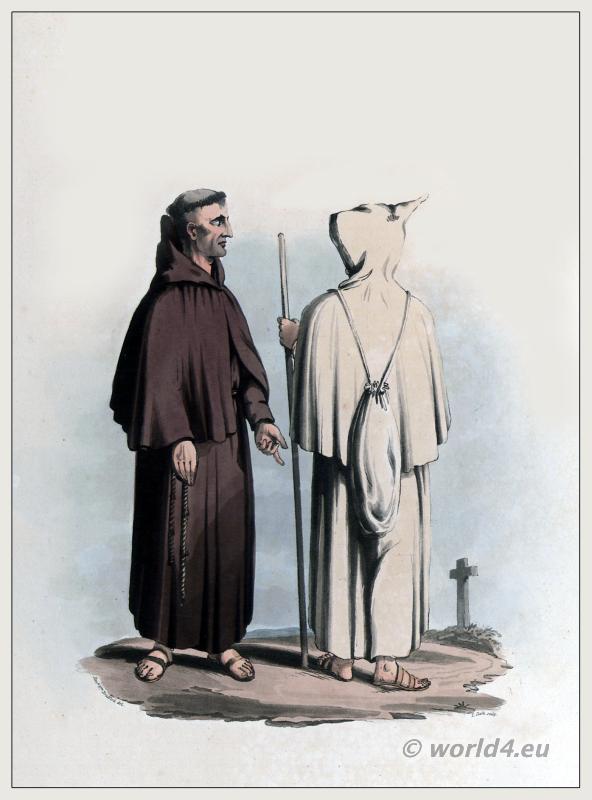
THE TRINITARIANS.
SAINTS JOHN OF MATHA AND FELIX OF VALOIS. – REDEMPTION OF CAPTIVES. – RELAXATION. – DISCALCED TRINITARIANS. – NUNS OF THE ORDER.
The Trinitarian Order, (completely lat. Ordo Sanctissimae Trinitatis redemptionis captivorum, Order of the Most Holy Trinity and the Redemption of Prisoners, order abbreviation OSsT); is an order in the Roman Catholic Church. It was founded at the turn of the 13th century and was originally a monastic order dedicated to the spiritual struggle against Islam. To him belong the Trinitarian Sisters, an order of nuns founded in 1236. A third order also emerged from the brotherhood of the Holy Trinity. The female branch also includes other regulated communities of nuns (abbreviation: HHTT) that emerged from the third order.
THIS order began in 1198, during the pontificate of Innocent III, and it was founded by Saints John of Matha and Felix of Valois. The former was born in France in 1160, and from his earliest infancy he showed signs of his future sanctity. Having studied theology at Paris, he was ordained priest. Several persons present at his first Mass had a vision in which they beheld an angel attired in a white robe, with a red and a blue cross on -his breast, his arms crossed before him, and his hands resting on the heads of two captives. Soon after this the saint retired into solitude, and joined a holy hermit named Felix of Valois, who lived in the diocese of Meaux.
One day, as these two saints conversed together, they beheld a white -deer with a red and blue cross between its horns. Connecting this wi th the apparition which had been seen on the day of the first Mass of St. John of Matha, they concluded that God desired something special of them. Hereupon they redoubled their prayers and austerities. Soon after an angel appeared to them three times in a dream, and commanded them to go to the Sovereign Pontiff, from whom they would learn their mission.
Having arrived at Rome, they assisted at the Mass of the Pope, and the same apparition that had been seen at Paris was again rendered visible. Innocent III., recognizing in this the finger of God, permitted them to found a religious order for the redemption of captives who were in the power of the infidels. On February 2nd, 1198, he invested them with a habit consisting of a white robe with a red and blue cross. The new order received the name of the Holy Trinity, and of the Redemption of Captives.
The two founders returned to France with letters from the Pope to the bishop of Paris and the abbot of Saint Victor, the latter being commanded to give them a rule and provide them with a convent. They established their first monastery, and the order began to increase, and among those who presented themselves to be received into it were men distinguished by their science and their merit. The rule composed by the abbot of Saint Victor was approved by the Pope, who gave to the order the convent of Saint Thomas, called della Novicella.
The special work of the order was now begun with the happy result that the first brethren sent to Morocco succeeded in liberating eighty-six captives in the year 1200. In the same year a house of the order was established in Flanders, and other monasteries were successively founded in Provence and in Spain. St. John of Matha himself went to Tunis, where he redeemed many prisoners.
Saint Felix meanwhile continued to extend the order in France. He died on November 20th, 1212. He was followed to the grave, the year after, by St. John of Matha, who breathed his last at Rome on December 21st, 1213, or 1214, according to some authors.
The original rule was mitigated by the authority of Pope Urban IV., and thus approved by Clement IV. in 1267. This order is founded on the rule of St. Augustine. It is considered by its members to belong to the orders of Regular Canons. The religious are allowed, under certain restrictions, to take charge of parishes. Their habit varies in different countries.
Before the Reformation the order possessed fifty-two houses in Ireland. In 1688 the religious of Spain separated from the others, and elected their own General, but in 1705 they were again united.
We have seen during the course of this history how religious orders, which had been fervent in the beginning, gradually underwent the fate of human institutions and declined. The Trinitarians formed no exception to the rule. Their general chapters, held in 1573 and in 1576, endeavored to reform the order, but unsuccessfully. What the chapters had failed to do was, however, effected by two saintly religious, Fathers Julian of Nantonville and Claude Aleph, who, notwithstanding many oppositions, succeeded in introducing a reform, which, however, did not extend to the entire order. The rule followed by the Reformed Religious requires continual abstinence from flesh-meat, except on Sundays and certain feasts of the year. They are also obliged to rise at midnight for Matins.
In 1596 was founded the Congregation of Discalced, or bare-footed Trinitarians, at Valdepeñas in Spain. The religious of this congregation wear sandals. Father John Baptist of the Conception is considered the founder of this reform. He had studied with the Discalced Carmelites, whose example exercised a great influence over him and it had been his desire to enter their order, but his parents prevented him. He became a Trinitarian at Toledo in 1580, and seventeen years later joined the Fathers, who had taken up their abode at Valdepeñas, and he was appointed their Superior. He had much to suffer from the other religious, but persevered in spite of all obstacles, and died on February 14, 1613.

Paul V., in 1609, had permitted these religious to be governed by a Vicar-General, subject to the General of the order. In the same year they were admitted to the number of the Mendicants. In 1636 Urban VIII. separated them from the jurisdiction of the order, and permitted them to elect their own General. The reform spread to Poland, Germany, Austria, and Italy.
While the Congregation of Discalced Trinitarians was being founded in Spain, Father Jerome Halies of the Blessed Sacrament was working at a similar establishment in France. He also succeeded in spite of opposition, and obtained the confirmation of his institute from Pope Urban VIII. in 1629. He spent some time in Spain to study the practices of the Discalced Trinitarians in that country. After a life full of merit, he died in his monastery of Saint Dennis at Rome, on January 30th, 1637. The houses of this reform were united into a separate province in 1670. Their observances very much resemble those of the Discalced Trinitarians of Spain, but the habit is slightly different. They both wear white, with a blue and red cross on their scapular. From 1688 until about the year 1714 the Discalced Trinitarians of Spain, faithful to the spirit of their vocation, had obtained the release for more than two thousand captives.
Saint John of Matha had also established a branch of his order for nuns, whose object it was to assist the brethren by their prayers. The first community of these pious women was founded in Spain. It was not until 1236 that they bound themselves by vows and became in the proper sense religious. In the beginning of the 17th century the Institute of Discalced Trinitarian Nuns was founded in Spain. They afterwards also obtained a foundation at Lima in Peru. There exists a Third Order of Trinitarians for people living in the world. The white scapular worn by many pious persons represents the habit of the Trinitarians. From the time of its foundation the order succeeded in releasing an incalculable number of captives. The religious of France alone obtained the liberty of about forty thousand, and the provinces of Spain of more than one hundred thousand. The order has thus certainly worked faithfully in the past, at the accomplishment of the task imposed upon it by Divine Providence.
According to their modified constitutions, Trinitarians are bound to fast every day in Advent and on all Fridays of the year which are not a double feast or octave. They are not bound to perpetual abstinence. During meals reading at table must not be dispensed with, not even when seculars are present.
On Friday the constitutions are read. No one is allowed to leave the monastery without permission. Matins and Lauds are recited at half-past five in the morning, and are followed by a quarter of an hour’s meditation. Another quarter of an hour is devoted to the same exercise after Compline in the evening. At present the General of the entire order is a Discalced Trinitarian, while those of the common observance are governed by a Vicar-General. The Gerarchia Cattolica, an annual directory of the hierarchy, published at Rome, places the Trinitarians among the mendicant orders.
Source: History of religious orders. A compendious and popular sketch of the rise and progress of the principal monastic, canonical, military, mendicant, and clerical orders and congregations of the Eastern and Western churches, together with a brief history of the Catholic church in relation to religious orders by Charles Warren Currier. New York, Murphy & McCarthy, 1894.
Related
Discover more from World4 Costume Culture History
Subscribe to get the latest posts sent to your email.






